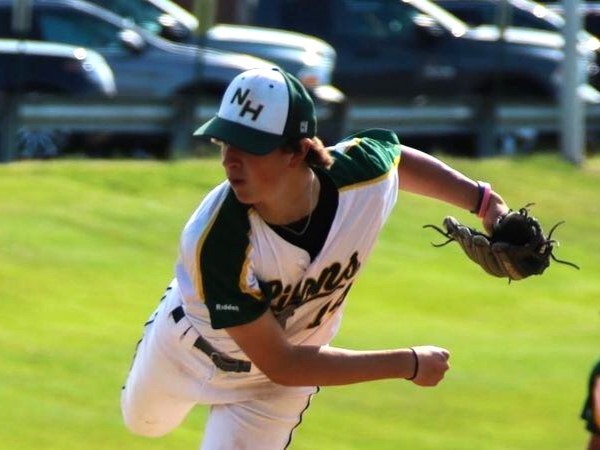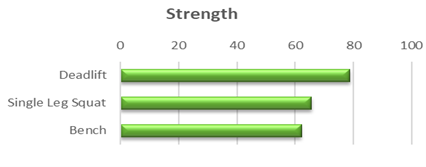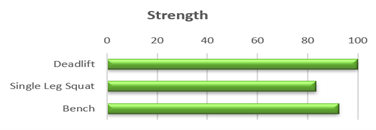
Rutgers Commit Chris Sand (Class 2025) joined us in September of last year looking to get a head start on the offseason and improve his mechanics, all with the intent of also bringing up his velocity ceiling. The 6’0” right hander came in weighing at 156 lbs. with a FB sitting 85-86, T87 mph in our initial evaluation. Now we sit here in the early part of the high school season and Chris has gained 3-4 mph, sitting 87-89 and T90 mph consistently, with more gains coming this spring and summer.
How did he do it?
Chris’s off-season training began with a complete assessment, including a movement screen, strength and power testing, and a mechanical breakdown of his delivery, combining both motion capture and video analysis.
Every pitcher wants to throw harder and getting them to do so is best achieved by targeting each athlete’s lowest hanging fruit. As for Chris, we identified several aspects of his assessment that had room for improvement. Let’s get down to the specifics.
Movement Screen / Mobility
The table portion of the assessment is crucial in not only identifying mobility issues that may be causing movement strategies to be sub-optimal but may also be limiting him from getting into more efficient positions on the mound. In many cases, some of the issues that are presented in this portion of the assessment will also present themselves when we are evaluating the pitcher’s mechanics in the video analysis portion of the assessment.
Here are two issues we discovered with Chris regarding his mobility / movement:
Tight Upper Half – When assessing Chris, we identified he had tight Pec Major, Pec Minor, and Lats. In conjunction with this, his Shoulder Flexion was also tight. The Pec Major, Pec Minor, and Lats are all internal rotators of the arm when pitching. Therefore, if these are tight, it can limit the pitcher’s ability to create a decent scap load as they begin to work down the mound.
This can ultimately lead to a stiff-arm path where we may see a “push” with the elbow through release. Shoulder Flexion is one’s ability to get overhead and because Chris presented with tightness here, we had to experiment with different arm slots in order to take stress off the anterior aspect of the shoulder.
Lower Half Mobility – Both Hip External and Internal Rotations are important for optimizing one’s back leg load in order to better apply force into the ground. If either of these are lacking, it will make it hard on a pitcher to effectively engage his pelvis / glute and thus apply force into the ground.
Body Composition
The lowest hanging fruit for Chris is his size and adding weight and lean muscle mass was and continues to be a main focus for him. Chris weighed in at RPP in late November at 156 lbs. Generally, the target height-to-weight ratio for our athletes is 2.5-2.7x. At 156 lbs. he needed to increase his muscle mass by 20-25 lbs.
As it is with many athletes at this age, gaining weight can be quite an uphill battle. Continuing to reiterate and drill the idea of eating more and dominating the weight room were key in discussions with Chris throughout the offseason. Since November, he has added 15 lbs. of lean muscle mass while maintaining a Body Fat Percentage of 12.0%. While this is a great start, there is still more room to improve.
Strength and Power
Strength and power testing gives us more information about the type of athlete we are dealing with and higher gains in these two categories means a higher velocity ceiling, with less having to be produced by the arm.
We were able to measure Chris’ initial Strength and Power numbers from November and compare them side-by-side with his numbers from the beginning of March. Below are his metrics:
Lower Half Power
-
- 25% increase in his CMJ Jump (8% above average in our offseason athletes)
- 23% increase in his Squat Jump (6% above average in our offseason athletes)
- 53% increase in Lead Leg RSI (21% above average in our offseason athletes)
Strength
-
- 7% increase in his Deadlift
- 21% increase in his Bench Press (even with our average for offseason athletes)
November Strength Results

March Strength Results

Mechanical Delivery
The final part of Chris’ evaluation was his mechanical breakdown, which we assessed through Motion Capture and Video Analysis. Motion capture data is great with being able to pick up things that are difficult to see with the naked eye, such as angular velocities and thus supplying us with greater insight as to what is really happening throughout his delivery.
Things he did well:
-
- Smooth Arm Path with Momentum: Chris has one of the cleanest arm actions that we observed in the Offseason Program. This allows him to keep his entire arm path relaxed and able to more easily, and efficiently get better layback, and create a “whippy” arm action.
- Hip-Shoulder Separation: After analyzing his Mocap Data, it was clear that he has a great amount of Hip-Shoulder Separation. Being a Narrow ISA (Infrasternal Angle), having good Hip-Shoulder Separation will allow him to get more rotational and optimize his delivery. Also, Hip-Shoulder Separation helps build tension in the throw by stretching the oblique sling. Good separation needs to be accompanied by good timing, which Chris shows he can sequence his Pelvis (1st) and Torso (2nd) in an elite way.
- Lead Leg Post-Up: Being able to land with force will help us not only transfer force back up through our kinetic chain, but it will help take stress off the arm and shoulder. Chris does an exceptional job at decelerating (1.538 Lead Leg RSI is ELITE) and accepting force from ground and using it to his advantage. It also allows him to fully rotate into his front hip, avoiding “slamming shut” and putting extra stress on the posterior shoulder.
Things he needed to work on:
-
- Arm Action: While Chris’ arm spiral is one of the cleanest in the gym, the action of it needed some work. He came to us saying in the prior offseason that he very often experienced shoulder pain and felt fatigued after normal bullpens. After analyzing his mechanics and assessment, we felt he should lower his arm slot slightly. As stated prior, this is mainly due to his lack of shoulder flexion.
- Torso Position at Foot Plant: When we get to weight bearing foot plant, we want our center of mass to stay stacked with the rest of our body. Chris’ torso was leaking forward as he worked down the slope. This was a by-product of his Early Heel Rotation with his back leg.
How we addressed his movement deficiencies?
Following the completion of the mechanical assessment, and once mobility issues begin to clean up, we generally prescribe throwing correctives in addition to his strength work in the gym. The intent here is to help improve overall movement patterns on the mound. Below are the drills we gave Chris to help improve these deficiencies:
Core Velocity Belt: Used to create and increase the feel and awareness of the back leg load (Feeding the problem; Focusing on staying back)
CVB Hinge Drill
2-Hop Drill: Used as an athletic movement to hold tension and activate our pelvis / glute
2-hop drill
Depth Drop: Used to generate force in the ground while engaging our glute
Depth Drop w/ Water Bag
Step Back: Used to help anchor back foot into the ground while working down the mound
Step back Drill
Swing the Gate: Used to stay stable in pelvis / glute as we gain momentum down the mound
Swing the Gate
Summary Results
Right from the get-go, Chris was locked-in this offseason. He wanted to be great and put in the necessary work to do so. Initially sitting mid 80s and topping 87 mph, Chris is now sitting 87-89 mph and T90 mph, with much more to come this spring as he learns how to utilize his additional lean muscle mass.
-
- Improving his upper half mobility and tissue quality of his Pec Major, Pec Minor and Lats in conjunction with improving his shoulder flexion should allow for a cleaner delivery and a healthier arm
- Holding tension in his pelvis / glute longer will help with producing greater amounts of force and the overall sequencing of his delivery
- A significant increase in strength, power, and muscle mass put his body in the best position to throw substantially harder this spring with less stress on the arm/shoulder.
Chris now heads into his junior year with an improved frame and improved velocity to go along with his elite pitch arsenal and top tier competitiveness. We are all excited to see what the future holds for Chris, as he is a prospect to keep your eye on over the next few years.
Best of luck this season Chris!
By Matthew Hartshorn (Pitching Coordinator)
You live too far to train with us in-house at RPP? You can now train with us on a REMOTE basis.


